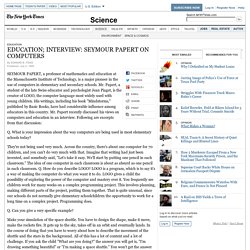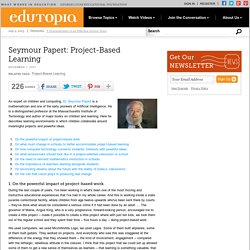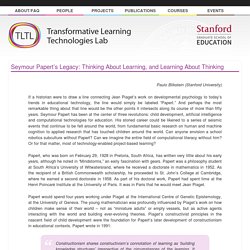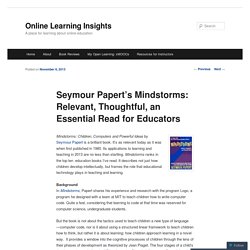

Bode Miller: World's Most Creative Skier. By Seymour Papert What I love about the Olympics is that they can be seen in many different ways: an affirmation of peace and internationalism; the pure joy of superb human performance; the less pure, but very human, identification with "our" athletes.

I'll be on the edge of my chair this week for Bode Miller. Besides being the fastest skier in the world he is the most creative: his style is so original that ski experts are amazed it works. I root for him as something of a Mainer because he developed his Olympic capacity while going to high school in our state and (which comes to the same thing) as an individualist who does things his way -- experts be damned. Many aspects of Bode would serve well for practicing the art of seeing the world through a lens focused on learning.
Once upon a time it was possible for a young person to learn the skills that would last a lifetime. Opportunities for developing independence are creeping into our homes most often without being noticed. EDUCATION - INTERVIEW - SEYMOUR PAPERT ON COMPUTERS. SEYMOUR PAPERT, a professor of mathematics and education at the Massachusetts Institute of Technology, is a major pioneer in the use of computers in elementary and secondary schools.

Mr. Papert, a student of the late Swiss educator and psychologist Jean Piaget, is the creator of LOGO, the computer language most widely used with young children. His writings, including his book ''Mindstorms,'' published by Basic Books, have had considerable influence among educators in this country. Mr. Seymour Papert: Project-Based Learning. An expert on children and computing, Dr.

Seymour Papert is a mathematician and one of the early pioneers of Artificial Intelligence. He is a distinguished professor at the Massachusetts Institute of Technology and author of major books on children and learning. Here he describes learning environments in which children collaborate around meaningful projects and powerful ideas. 1. On the powerful impact of project-based work.
During the last couple of years, I've been working in what's been one of the most moving and instructive educational experiences that I've had in my whole career. We used computers, we used MicroWorlds Logo, we used Legos. Back to Top 2. Well, first thing you have to do is to give up the idea of curriculum. If, for example, this Lego stuff is why a lot of kids love building robotic kinds of things and programming -- and they love doing that -- and you can connect that work to all the powerful ideas that are important for kids to know. 3. 4. 5. 6.
The Daily Papert. Seymour Papert’s Legacy: Thinking About Learning, and Learning About Thinking. Paulo Blikstein (Stanford University) If a historian were to draw a line connecting Jean Piaget’s work on developmental psychology to today’s trends in educational technology, the line would simply be labeled “Papert.”

And perhaps the most remarkable thing about that line would be the other points it intersects along its course of more than fifty years. Seymour Papert has been at the center of three revolutions: child development, artificial intelligence and computational technologies for education. His storied career could be likened to a series of seismic events that continue to be felt around the world, from fundamental basic research on human and machine cognition to applied research that has touched children around the world. Can anyone envision a school robotics subculture without Papert? Papert, who was born on February 29, 1928 in Pretoria, South Africa, has written very little about his early years, although he noted in “Mindstorms,” an early fascination with gears. Seymour Papert’s Mindstorms: Relevant, Thoughtful, an Essential Read for Educators. Mindstorms: Children, Computers and Powerful Ideas by Seymour Papert is a brilliant book.

It’s as relevant today as it was when first published in 1980. Its applications to learning and teaching in 2013 are no less than startling. Mindstorms ranks in the top ten education books I’ve read. It describes not just how children develop intellectually, but frames the role that educational technology plays in teaching and learning.
Background In Mindstorms, Papert shares his experience and research with the program Logo, a program he designed with a team at MIT to teach children how to write computer code. But the book is not about the tactics used to teach children a new type of language—computer code, nor is it about using a structured linear framework to teach children how to think, but rather it is about learning; how children approach learning in a novel way. The turtle in logo, controlled by the student’s programmed instruction, operates a pen mechanism that creates drawings on paper. Professor Seymour Papert.